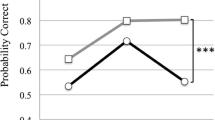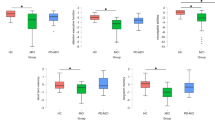Abstract
Patients with cerebellar lesions present some affective and cognitive disorders, defining a peculiar pattern of cognitive impairment, so-called cerebellar cognitive affective syndrome. This pattern has been confirmed in many genotypes of spinocerebellar ataxias (SCA), a group of genetically defined pathologies characterized by the degeneration of the cerebellum and its connections. Recently, in SCA patients, some authors focused the interest on social cognition evidencing an impairment of theory of mind and basic emotion recognition by verbal material. The recognition of emotions in faces is an essential component of social cognition; therefore, we assessed this ability in SCA patients, expanding the study from the basic verbal emotions to the basic and social visual emotion recognition. We assessed facial emotion recognition using two basic and social emotion tasks in a group of SCA patients together with a complete clinical and neuropsychological evaluation. We compared results with the performance of a control group. We demonstrated a significant difference between patients and controls both in basic and social emotion recognition, although we found a specific impairment only for social emotions. The deficit was not correlated to clinical and demographic features. The cognitive and psychological profile did not explain the impairment in emotion recognition. This result supports the hypothesis that the impairment in social emotion recognition could be specifically related to a defect in the corticocerebellar network.

Similar content being viewed by others
References
Bruce V, Young A. Understanding face recognition. Br J Psychol. 1986;77(Pt 3):305–27.
Duchaine BC, Parker H, Nakayama K. Normal recognition of emotion in a prosopagnosic. Perception. 2003;32(7):827–38.
Hobson RP, Ouston J, Lee A. What’s in a face? The case of autism. Br J Psychol. 1988;79(Pt 4):441–53.
Vuilleumier P, Pourtois G. Distributed and interactive brain mechanisms during emotion face perception: evidence from functional neuroimaging. Neuropsychologia. 2007;45(1):174–94.
Barrett LF, Bar M. See it with feeling: affective predictions during object perception. Philos Trans R Soc Lond B Biol Sci. 2009;364(1521):1325–34.
Adolphs R. Neural systems for recognizing emotion. Curr Opin Neurobiol. 2002;12(2):169–77.
Kesler-West ML, Andersen AH, Smith CD, Avison MJ, Davis CE, Kryscio RJ, et al. Neural substrates of facial emotion processing using fMRI. Brain Res Cogn Brain Res. 2001;11(2):213–26.
Vuilleumier P, Driver J. Modulation of visual processing by attention and emotion: windows on causal interactions between human brain regions Phil. Trans R Soc B. 2007;362:837–55.
LeDoux JE. Emotion circuits in the brain. Annu Rev Neurosci. 2000;23:155–84.
Vuilleumier P, Armony JL, Driver J, Dolan RJ. Effects of attention and emotion on face processing in the human brain: an event-related fMRI study. Neuron. 2001;30:829–41.
Mier D, Lis S, Neuthe K, Sauer C, Esslinger C, Gallhofer B, et al. The involvement of emotion recognition in affective theory of mind. Psychophysiology. 2010;47(6):1028–39.
Zaja RH, Rojahn J. Facial emotion recognition in intellectual disabilities. Curr Opin Psychiatry. 2008;21(5):441–4.
Harms MB, Martin A, Wallace GL. Facial emotion recognition in autism spectrum disorders: a review of behavioral and neuroimaging studies. Neuropsychol Rev. 2010;20(3):290–322.
Courchesne E. Brainstem, cerebellar and limbic neuroanatomical abnormalities in autism. Curr Opin Neurobiol. 1997;7(2):269–78.
Chugani DC, Muzik O, Rothermel R, Behen M, Chakraborty P, Mangner T, et al. Altered serotonin synthesis in the dentatothalamocortical pathway in autistic boys. Ann Neurol. 1997;42(4):666–9.
Fusar-Poli P, Placentino A, Carletti F, Landi P, Allen P, Surguladze S, et al. Functional atlas of emotional faces processing: a voxel-based meta-analysis of 105 functional magnetic resonance imaging studies. J Psychiatry Neurosci. 2009;34(6):418–32.
Turner BM, Paradiso S, Marvel CL, Pierson R, Boles Ponto LL, Hichwa RD, et al. The cerebellum and emotional experience. Neuropsychologia. 2007;45(6):1331–41.
Schutter DJ, Enter D, Hoppenbrouwers SS. High-frequency repetitive transcranial magnetic stimulation to the cerebellum and implicit processing of happy facial expressions. J Psychiatry Neurosci. 2009;34(1):60–5.
Burk K, Globas C, Bosch S, Klockgether T, Zuhlke C, Daum I, et al. Cognitive deficits in spinocerebellar ataxia type 1, 2, and 3. J Neurol. 2003;250(2):207–11.
Le Pira F, Zappala G, Saponara R, Domina E, Restivo D, Reggio E, et al. Cognitive findings in spinocerebellar ataxia type 2: relationship to genetic and clinical variables. J Neurol Sci. 2002;201(1–2):53–7.
Suenaga M, Kawai Y, Watanabe H, Atsuta N, Ito M, Tanaka F, et al. Cognitive impairment in spinocerebellar ataxia type 6. J Neurol Neurosurg Psychiatry. 2008;79(5):496–9.
Stone J, Smith L, Watt K, Barron L, Zeman A. Incoordinated thought and emotion in spinocerebellar ataxia type 8. J Neurol. 2001;248(3):229–32.
Torrens L, Burns E, Stone J, Graham C, Wright H, Summers D, et al. Spinocerebellar ataxia type 8 in Scotland: frequency, neurological, neuropsychological and neuropsychiatric findings. Acta Neurol Scand. 2008;117(1):41–8.
Schmahmann JD, Sherman JC. The cerebellar cognitive affective syndrome. Brain. 1998;121(Pt 4):561–79.
Garrard P, Martin NH, Giunti P, Cipolotti L. Cognitive and social cognitive functioning in spinocerebellar ataxia: a preliminary characterization. J Neurol. 2008;255(3):398–405.
Sokolovsky N, Cook A, Hunt H, Giunti P, Cipolotti L. A preliminary characterisation of cognition and social cognition in spinocerebellar ataxia types 2, 1, and 7. Behav Neurol. 2010;23(1–2):17–29.
Trouillas P, Takayanagi T, Hallett M, Currier RD, Subramony SH, Wessel K, et al. International Cooperative Ataxia Rating Scale for pharmacological assessment of the cerebellar syndrome. The Ataxia Neuropharmacology Committee of the World Federation of Neurology. J Neurol Sci. 1997;145(2):205–11.
Ekman P, Friesen WV. Constants across cultures in the face and emotion. J Pers Soc Psychol. 1971;17(2):124–9.
Tamietto M, Adenzato M, Geminiani G, de Gelder B. Fast recognition of social emotions takes the whole brain: interhemispheric cooperation in the absence of cerebral asymmetry. Neuropsychologia. 2007;45(4):836–43.
Folstein MF, Folstein SE, McHugh PR. Mini-mental state. A practical method for grading the cognitive state of patients for the clinician. J Psychiatr Res. 1975;12(3):189–98.
Giovagnoli AR, Del Pesce M, Mascheroni S, Simoncelli M, Laiacona M, Capitani E. Trail making test: normative values from 287 normal adult controls. Ital J Neurol Sci. 1996;17(4):305–9.
Stroop JR. Studies of interference in serial verbal reactions. J Exp Psychol. 1935;18:643–62.
Buschke H, Fuld PA. Evaluating storage, retention, and retrieval in disordered memory and learning. Neurology. 1974;24(11):1019–25.
Benton AL. A visual retention test for clinical use. AMA Arch Neurol Psychiatry. 1945;54:212–6.
Shallice T. Specific impairments of planning. Philos Trans R Soc Lond B Biol Sci. 1982;298(1089):199–209.
Heaton RK, Chelune GJ, Talley JL, Kay GG, Curtiss G, Wisconsin Card Sorting Test. ed. Florence: Organizzazioni Speciali; 2000.
Novelli G, Papagno C, Capitani E, Laiacona M, Cappa SF, Vallar G. Tre test clinici di ricerca e produzione lessicale. Taratura su soggetti normali. Arch Psicol Neurol Psichiatr. 1986;47(4):477–506.
Benton A, Sivan A, Hamsher K, Varney N, Spreen O, Contributi per un assessment neuropsicologico. ed. Florence:Organizzazioni Speciali; 2000.
Zung WW. A Self-Rating Depression Scale. Arch Gen Psychiatry. 1965;12:63–70.
Spielberger CD, Manual for the state/trait anxiety inventory (form Y): (self evaluation questionnaire). ed. Palo Alto: Consulting Psychologists Press; 1983.
Finner H. Some new inequalities for the RAND distribution with application to the determination of optimum significance levels of multiple range tests. J Am Stat Assoc. 1990;85:191–4.
Finner H. On a monotonicity problem in step-down multiple test procedures. J Am Stat Assoc. 1993;88:920–3.
Benjamini Y, Drai D, Elmer G, Kafkafi N, Golani I. Controlling the false discovery rate in behavior genetics research. Behav Brain Res. 2001;125(1–2):279–84.
Adolphs R, Tranel D, Damasio AR. Dissociable neural systems for recognizing emotions. Brain Cogn. 2003;52:61–9.
Adolphs R, Tranel D, Damasio H, Damasio A. Impaired recognition of emotion in facial expressions following bilateral damage to the human amygdala. Nature. 1994;372:669–72.
Orsi L, D’Agata F, Caroppo P, Franco A, Caglio M, Avidano F, et al. Neuropsychological pictures of 33 spinocerebellar ataxia cases. J Clin Exp Neuropsychol. 2011;6:1–11.
Klinke I, Minnerop M, Schmitz-Hubsch T, Hendriks M, Klockgether T, Wullner U, et al. Neuropsychological features of patients with spinocerebellar ataxia (SCA) types 1, 2, 3, and 6. Cerebellum. 2010;9(3):433–42.
Le Pira F, Giuffrida S, Maci T, Marturano L, Tarantello R, Zappala G, et al. Dissociation between motor and cognitive impairments in SCA2: evidence from a follow-up study. J Neurol. 2007;254(10):1455–6.
Timmann D, Drepper J, Frings M, Maschke M, Richter S, Gerwig M, et al. The human cerebellum contributes to motor, emotional and cognitive associative learning. A review. Cortex. 2009;46(7):845–57.
Habas C, Kamdar N, Nguyen D, Prater K, Beckmann CF, Menon V, et al. Distinct cerebellar contributions to intrinsic connectivity networks. J Neurosci. 2009;29(26):8586–94.
Ito M. Control of mental activities by internal models in the cerebellum. Nat Rev Neurosci. 2008;9(4):304–13.
Nomura M, Iidaka T, Kakehi K, Tsukiura T, Hasegawa T, Maeda Y, et al. Frontal lobe networks for effective processing of ambiguously expressed emotions in humans. Neurosci Lett. 2003;348(2):113–6.
Estrada R, Galarraga J, Orozco G, Nodarse A, Auburger G. Spinocerebellar ataxia 2 (SCA2): morphometric analyses in 11 autopsies. Acta Neuropathol. 1999;97(3):306–10.
Manto MU. The wide spectrum of spinocerebellar ataxias (SCAs). Cerebellum. 2005;4(1):2–6.
van Wingen GA, van Eijndhoven P, Tendolkar I, Buitelaar J, Verkes RJ, Fernandez G. Neural basis of emotion recognition deficits in first-episode major depression. Psychol Med. 2010;8:1–9.
Lenth RV. Some practical guidelines for effective sample size determination. Am Stat. 2001;55:187–93.
Cohen J. A power primer. Psychol Bull. 1992;112:155–9.
de Gelder B, Meeren HK, Righart R, van den Stock J, van de Riet WA, Tamietto M. Beyond the face: exploring rapid influences of context on face processing. Prog Brain Res. 2006;155:37–48.
Barrett LF, Lindquist KA, Gendron M. Language as context for the perception of emotion. Trends Cogn Sci. 2007;11:327–32.
Carroll JM, Russell JA. Do facial expressions signal specific emotions? Judging emotion from the face in context. J Pers Soc Psychol. 1996;70:205–18.
Aviezer H, Hassin RR, Ryan J, Grady C, Susskind J, Anderson A, et al. Angry, disgusted, or afraid? Studies on the malleability of emotion perception. Psychol Sci. 2008;19:724–32.
Tamietto M, de Gelder B. Affective blindsight in the intact brain: Neural interhemispheric summation for unseen fearful expressions. Neuropsychologia. 2008;46(3):820–8.
Tamietto M, Latini Corazzini L, de Gelder B, Geminiani G. Functional asymmetry and interhemispheric cooperation in the perception of emotions from facial expressions. Experimental Brain Research. 2006;171(3):389–404.
Bar M. Visual objects in context. Nat Rev Neurosci. 2004;5(8):617–29.
Acknowledgements
We wish to thank Dr. Federica Avidano, Dr. Cristina Manzone and Dr. Chiara Caroppo for their contributions to this work. This research was supported by Compagnia di San Paolo, “Cervelletto e cognitività”, 2005–2006. The authors would also like to thank patients who participated in the study and their families.
Conflict of Interests
Authors declare no financial or personal conflict of interests.
Author information
Authors and Affiliations
Corresponding author
Additional information
Federico D’Agata and Paola Caroppo contributed equally to this work.
Electronic Supplementary Material
Below is the link to the electronic supplementary material.
Rights and permissions
About this article
Cite this article
D’Agata, F., Caroppo, P., Baudino, B. et al. The Recognition of Facial Emotions in Spinocerebellar Ataxia Patients. Cerebellum 10, 600–610 (2011). https://doi.org/10.1007/s12311-011-0276-z
Published:
Issue Date:
DOI: https://doi.org/10.1007/s12311-011-0276-z




